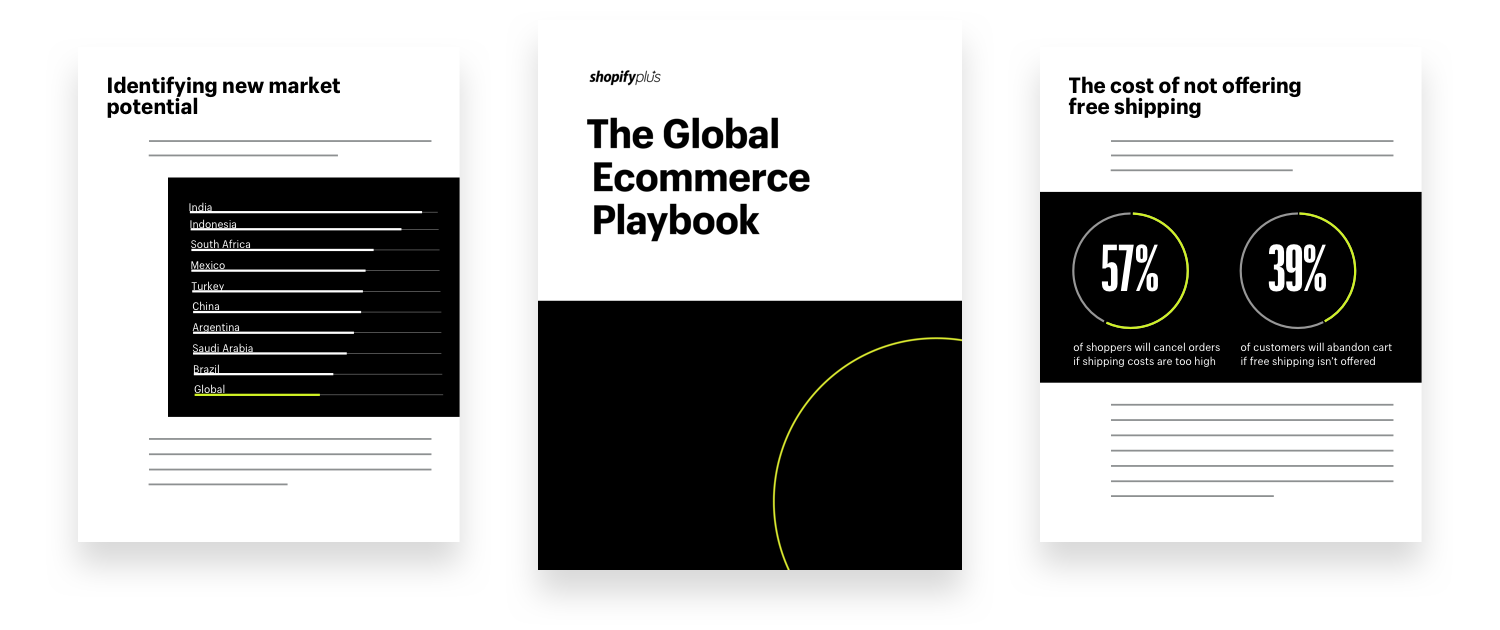Global ecommerce is many things—cross-border commerce, borderless business, international online retail. But more important than what it is, is what it isn’t.
Global ecommerce is not a luxury. It’s not one strategy among many. But going global is a necessity.
Unfortunately, it’s also fraught with questions: Where to invest? What countries present the best product-market fit? How do you attract non-local buyers? Which is most important: translation, currencies, payment options, or something else entirely?
This guide will give you an inside look on the global ecommerce, with tips on how you can expand into the market.
- What is global ecommerce?
- How big is the global ecommerce market?
- Global ecommerce sales growth
- 11 top global ecommerce trends to watch
- It’s time to go cross-border
1. What is global ecommerce?
First things first: global ecommerce is the selling products or services across geopolitical borders from a company’s country of origin, normally defined as its founding or incorporating location. Products or services are sold into non-native markets via online sales and marketing.
Cumulative data anticipates a 27.6% increase in worldwide ecommerce sales over the most recently tracked period.
Numbers of that scale are hard to wrap our heads around. They’re at once invigorating and daunting. If your company is staring down that $4.8 trillion barrel and wondering, “Where do we begin?” rest assured, you’re not alone.
The advantages of international ecommerce are:
- Easier expansion into foreign markets
- Easier-to-find product-market fit
- Shorter B2B sales cycles
- Quicker building of international presence
- Lower barriers to entry
As Harvard Business Review wrote: “Business leaders are scrambling to adjust to a world few imagined possible just a year ago. The myth of a borderless world has come crashing down. Traditional pillars of open markets—the United States and the UK—are wobbling, and China is positioning itself as globalization’s staunchest defender.”
We’ll unpack that quote and more below. For now, the big idea is simple: the shadow of global ecommerce looms too large to ignore.
2. How big is the global ecommerce market?
The global ecommerce market is expected to total $4.89 trillion in 2021. That figure is estimated to grow over the next few years, showing that borderless ecommerce is becoming a profitable option for online retailers.
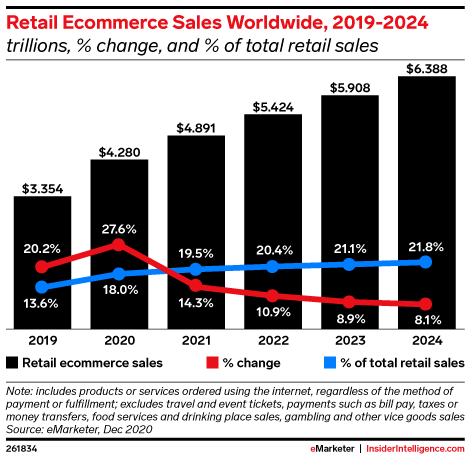
Two years ago, only 13.6% of sales were made from online purchases. Today, that number is expected to reach 19.5% in 2021, a 45.8% increase in ecommerce market share over two years. Growth is expected to continue, reaching 21.8% by 2024, which translates to an 8.2 percentage point increase in just five years.
3. Global ecommerce sales growth
Global retail sales growth will continue to rise and take up more retail market share. According to eMarketer, online retail sales will reach $6.39 trillion, with ecommerce taking up 21.8% of total retail sales.
Although retail had a tough year in 2020, every national market covered by eMarketer saw double-digit ecommerce growth. Latin America saw incredible growth (36.7%), despite a 3.4% drop in overall retail sales. Argentina’s ecommerce sector grew by 79% in 2020, followed by Singapore, at 71.1%.
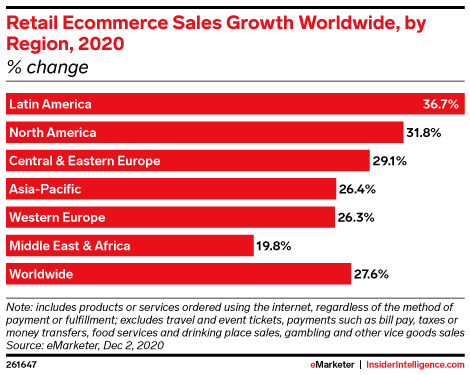
China continues to lead the global ecommerce market, with total online sales just under the $2.8 trillion mark. It also has the world's most digital buyers, with 792.5 million, representing 33.3% of the global total. China is set to become the first country in history to transact more than half of its retail sales online, with 52.1% of retail happening through ecommerce.
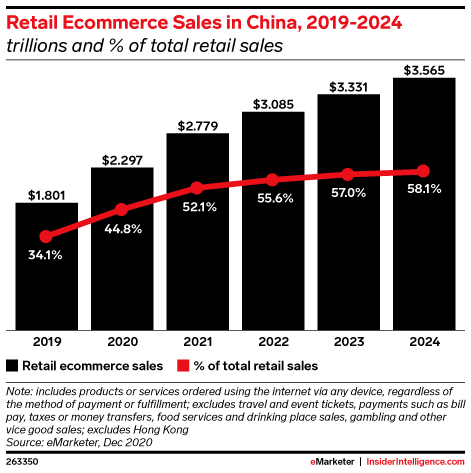
The United States ecommerce market is forecast to reach over $843 billion in 2021, less than a third of China’s. After China and the US, the third-largest ecommerce market is the United Kingdom. The UK’s total ecommerce sales are expected to bring in $169 billion, which is a slight dip from $180 billion in 2020.
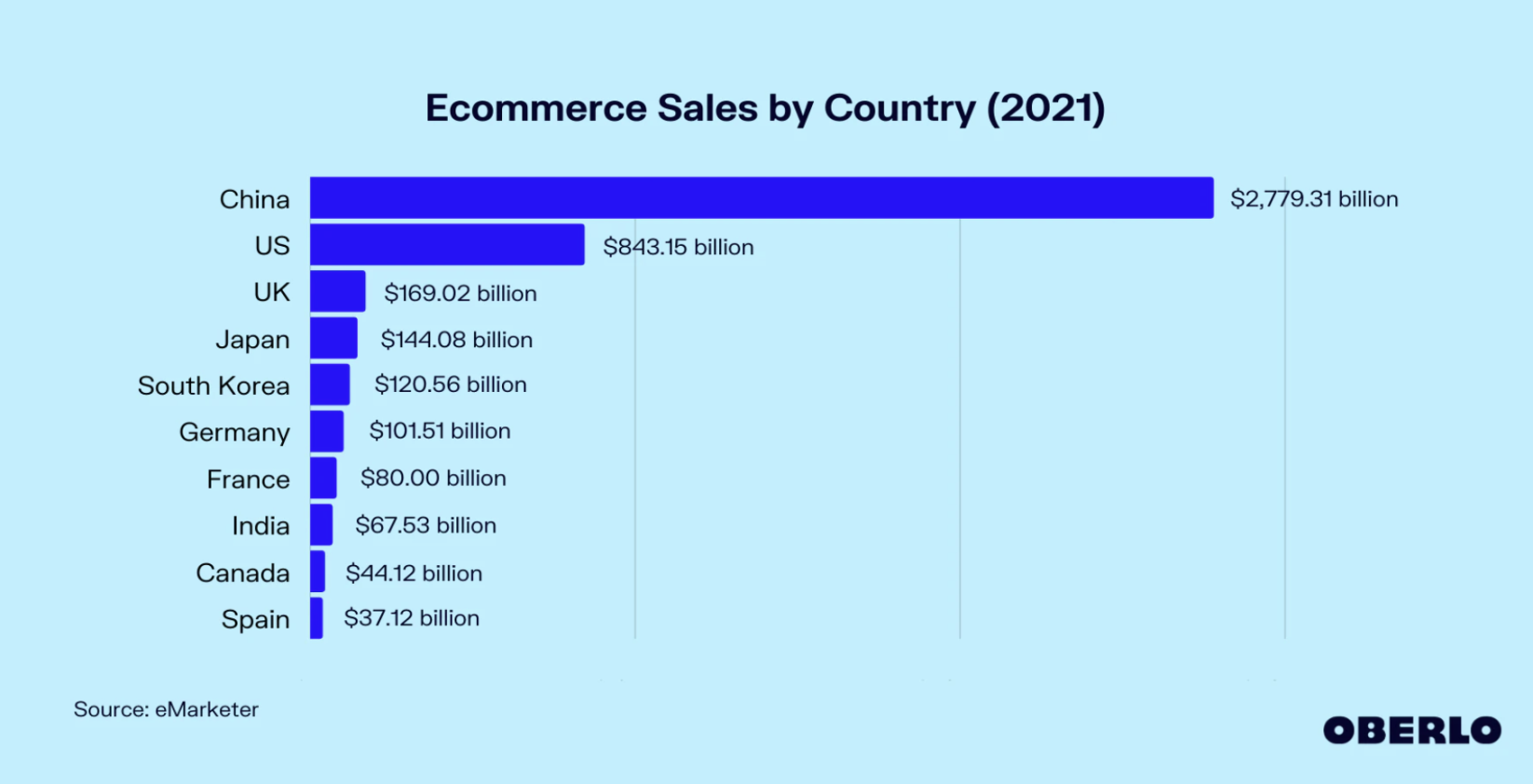
Two other countries round out the top five ecommerce markets: Japan is forecast at $144.08 billion in 2021, and South Korea is expected to bring in $120.56 billion.
Three of the top five markets are part of the Asia-Pacific region, accounting for 62.6% of all online sales. This makes it a major market for retailers to focus their efforts on.
Casey Armstrong, CMO at ecommerce fulfillment brand ShipBob, adds, “While a lot of focus in ecommerce centers around the United States and Canada, there is a lot to learn from other large international players who are seeing an even more accelerated growth rate in ecommerce.”
He adds, “Merchants can shift where they sell based on this data and the demand on ecommerce from these countries. At ShipBob, it’s why we have opened fulfillment centers in Canada and the UK and are about to open another in Australia.”
Read more: Localize, Don’t Internationalize: How the UK’s Simba Hit $100M+ Going Global
4. 11 top global ecommerce trends to watch
The new norm? It’s mobile shopping
The COVID-19 pandemic made a significant impact on ecommerce trends around the world. With brick-and-mortar stores shuttering overnight, shoppers flocked to the internet to buy their things. Experts say the pandemic accelerated the shift to online shopping by as much as five years.
M-commerce, or mobile commerce, involves shopping online through a mobile device like a smartphone or tablet. M-commerce will continue to break out over the next few years. Technological advances make it easier for people to shop on their phones.
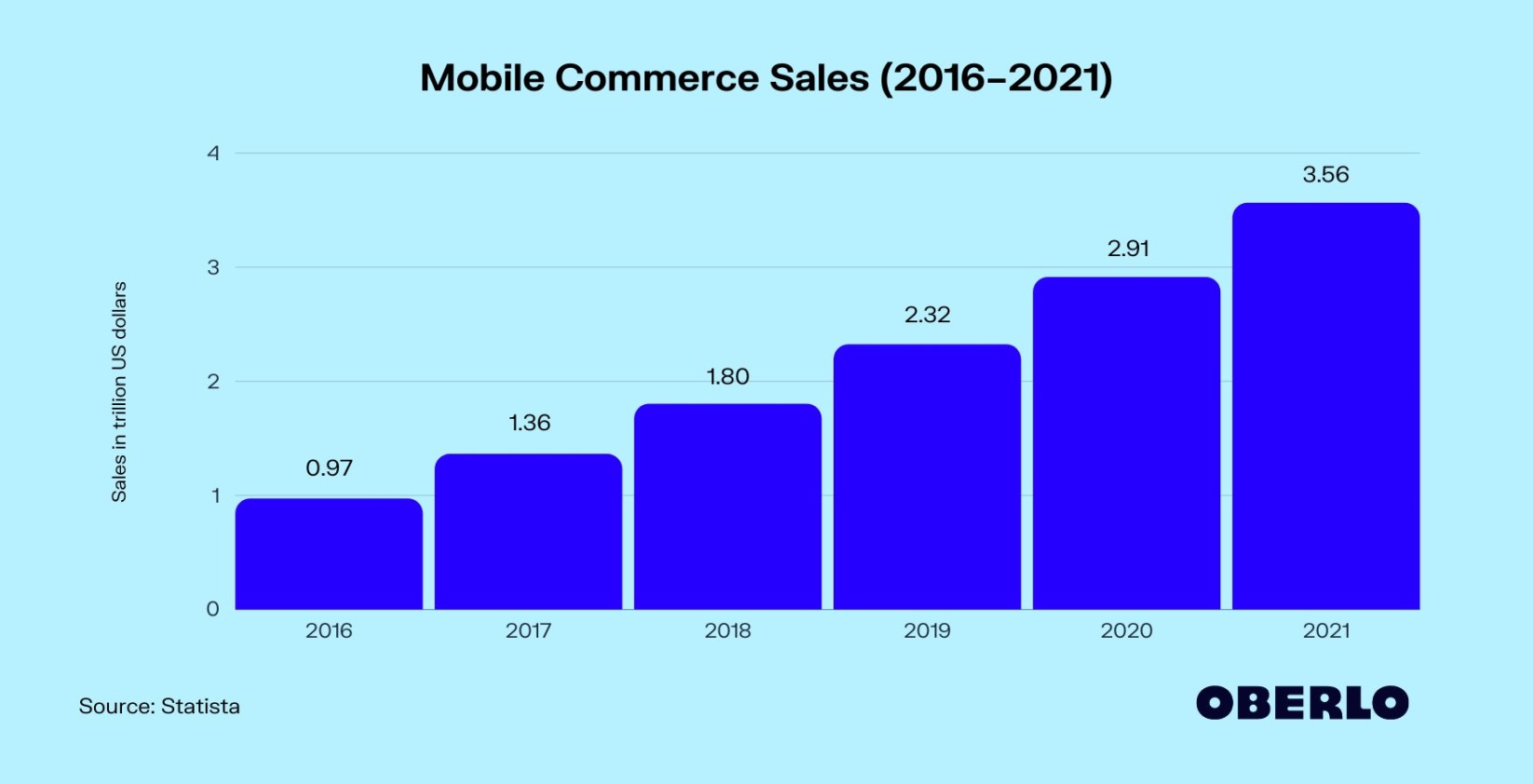
In fact, three out of four consumers say they buy from their smartphones because it saves time.
Insider Intelligence forecasts that m-ecommerce volume will rise at a 25.5% compound annual growth rate (CAGR) until 2024, hitting $488 billion in sales, or 44% of all e-commerce transactions.
Building supply chain resilience
The impact the coronavirus pandemic made on supply chains was, according to Morris Cohen, Wharton professor of operations, information and decisions, “a major disruption, along the lines of having an earthquake or tsunami.” For decades, the core features of supply chain management were:
- Globalization
- Low-cost supply
- Minimal inventory
When the coronavirus broke supply chains around the world, it drove companies to focus on building supply chain resilience, or to think of ways to keep supply chains from halting and restoring them quickly when they do.
A recent study from Deloitte revealed that nine in 10 companies are making significant investments to improve their supply chain resilience, with 95% of executive panels indicating stronger supply chains as “important” or “very important.”
Not only does a strong supply chain make ecommerce brands more nimble, it also gives them the power to scale and launch new go-to-market approaches for cross-border ecommerce.
Do you know how resilient your supply chain needs to be? To find out, Garntner identified six critical factors.
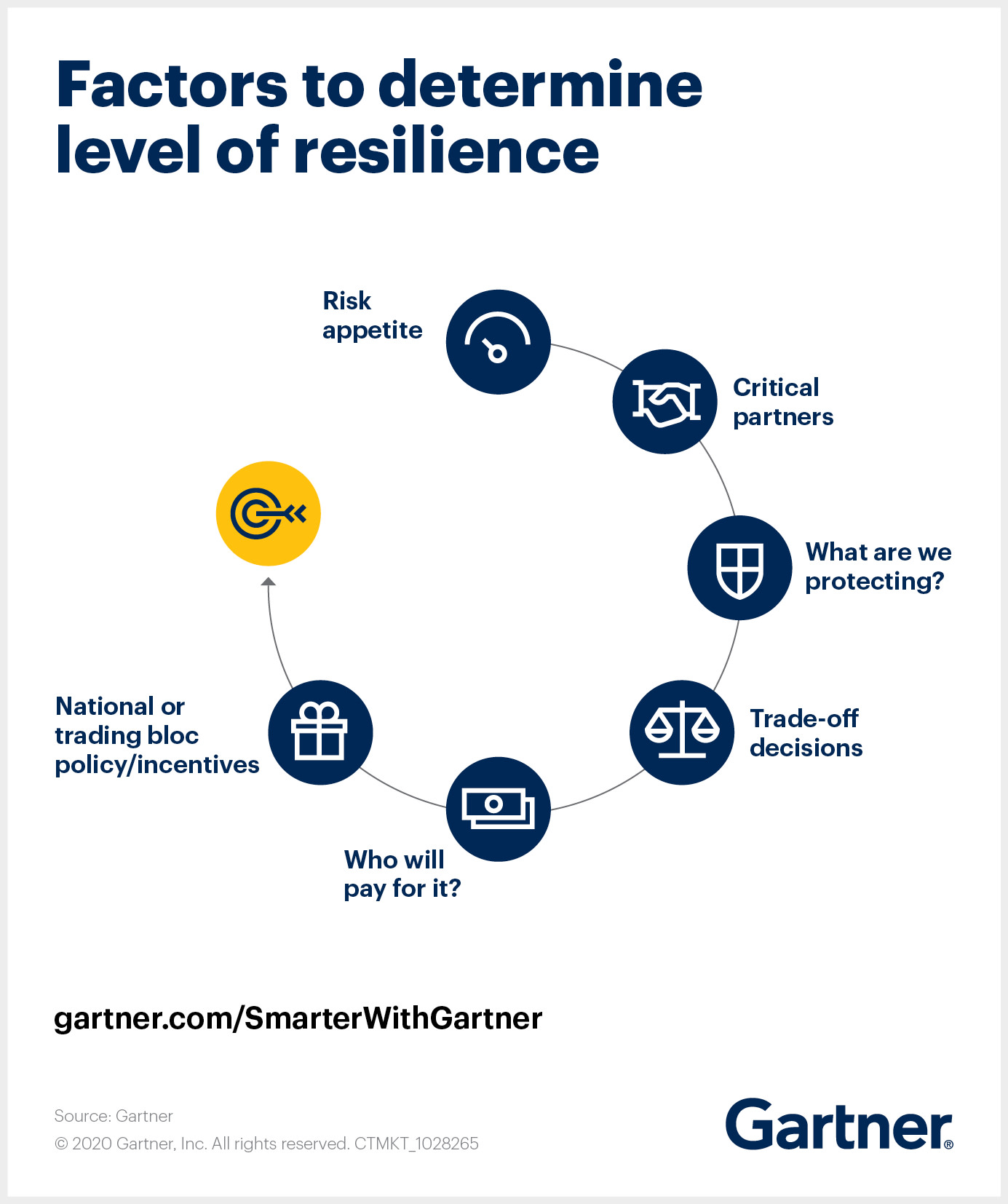
These include:
- Risk appetite. How much risk can your organization can absorb?
- Critical partners. Evaluate if partners can weather specific conditions and support a diversification strategy.
- What are you protecting? Is it a product line, government contract, or market access?
- Trade-off decisions. is it worth establishing resistance for existing networks or pursuing diversification for upcoming products?
- Who will pay for it? More resilience is an investment that you need to pay for. How will you offset the costs?
- National or trading bloc policies and incentives. Do they offer incentives to organizations that move manufacturing back or closer to the end customer?
Learn more: Scaling a Global Ecommerce Business: Three Keys from $100M+ Enterprises
Ecommerce moves beyond the Western world
By 2023, retail ecommerce sales in Asia-Pacific are projected to be greater than the rest of the world combined. This is due to: (1) rapid urbanization and technological advancements; (2) more than 85% of new middle-class growth residing in APAC; and (3) a host of government and private-led initiatives in China.
On the B2B front, manufacturing in APAC and China has undergone a renaissance. As a result, the B2B disparity is even clearer.
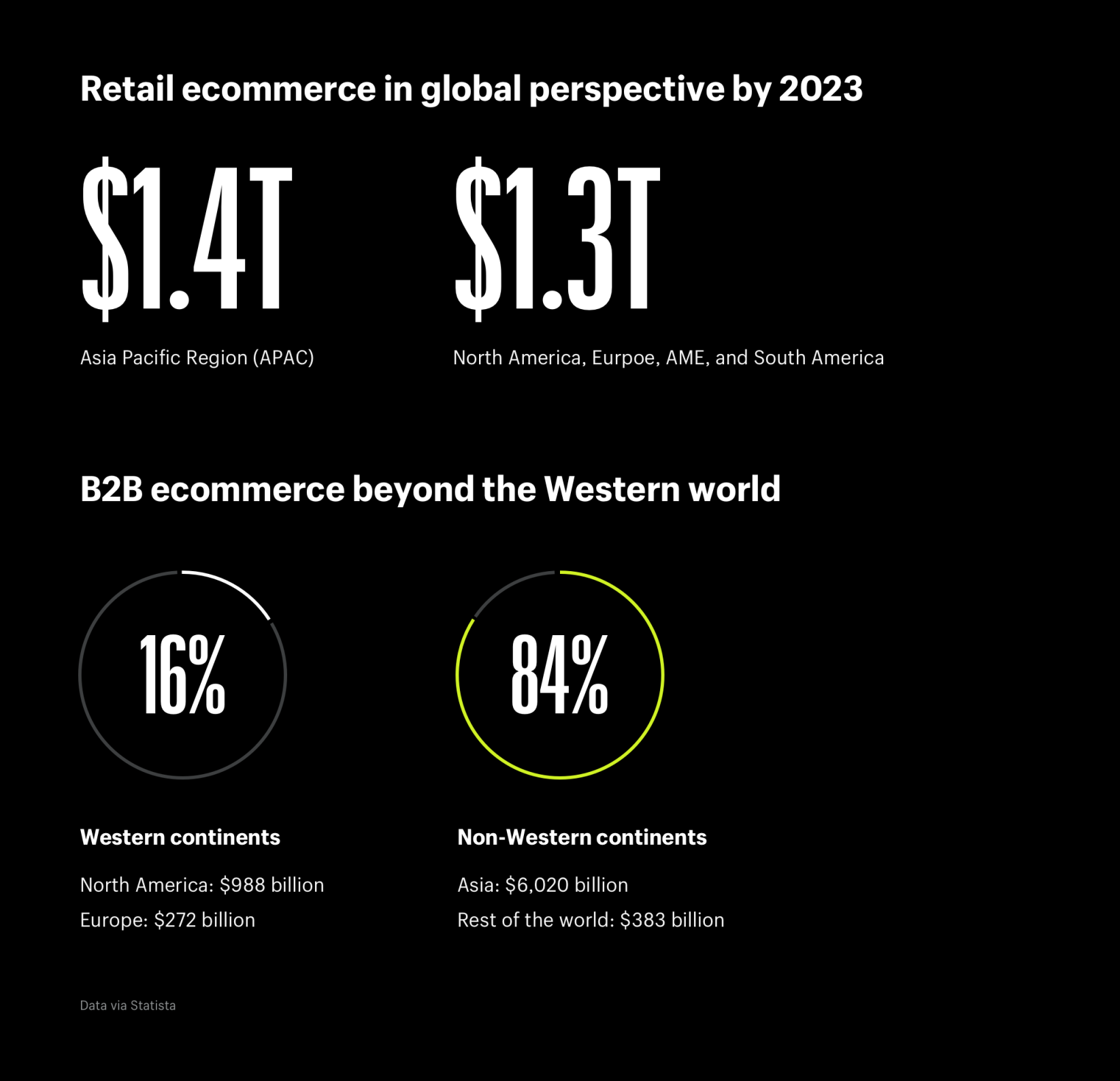
Entering China—and to a lesser degree APAC as a whole—presents a handful of thorny challenges:
- China causes sites on foreign servers to load painfully slow, dragging down onsite conversion rates and search engine rankings.
- Advertising and social content via Facebook, Instagram, YouTube, and Google are unavailable in China, even though Chinese companies are able to enter Western markets.
- Chinese consumers use ecommerce.
Is there an answer? Check out our report on the Shopify Effect and how entrepreneurs are changing the world.
Learn more: Global Ecommerce Marketplaces: The Complete List by Region and Sales
Online shopping happening outside borders
To start, going global doesn’t necessarily require a global presence. Online shoppers are increasingly looking outside their country’s borders for purchases. In fact, during one evaluation, the majority of overseas purchases from India was the United States.
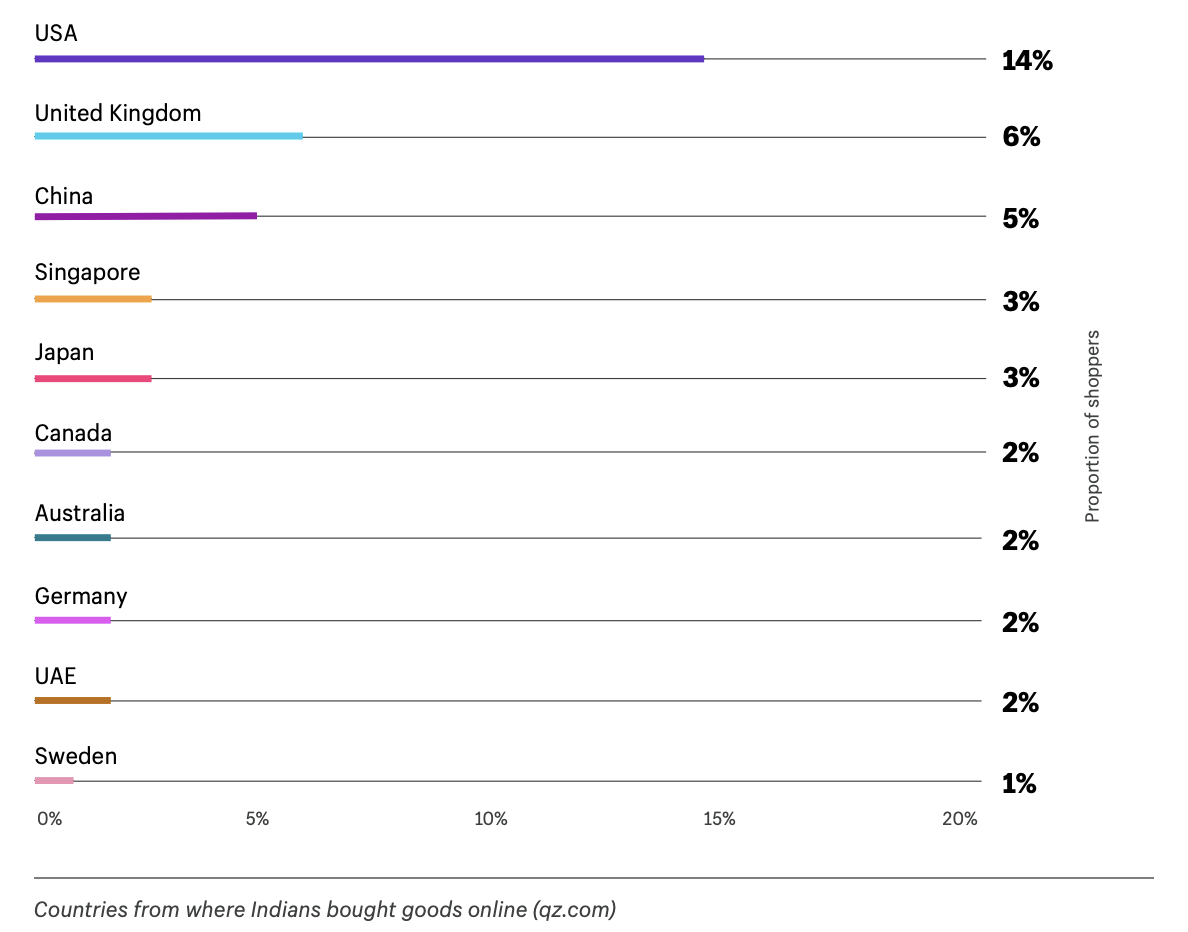
None of that demands multiple storefronts for each location or setting up international warehousing and fulfillment. One of the simplest ways to begin testing new markets is to prioritize online advertising or social media abroad. This requires an international approach to Google Ads, Product Listing Ads, Facebook, and Instagram through geographic targeting.
Promoting social content and advertising online in other countries, even if all you do is track engagement rather than sales, tests viability. But perhaps the best strategy is to experiment with marketplaces in target regions, where 62% of global online sales now take place.
Learn more: A Guide to International Warehouses in Global Ecommerce
China and APAC expansion
Despite those challenges, numerous DTC leaders are already making headway (and significant revenue). Tim Brown, co-founder of Allbirds, recently called China the “brand’s horizon for future expansion.”
The question is: how are they doing this?
Strategies typically cluster around three approaches:
- Partnering with local vendors.
- Investing in an on-the-ground team. Depending on size, this may include localization, marketing, logistics, customer support, sales, and engineering.
- Establishing an online presence through third-party marketplaces—i.e., Tmall and JD—and/or a branded ecommerce site. Branded sites are more costly, but they provide more data and better customer relationships.
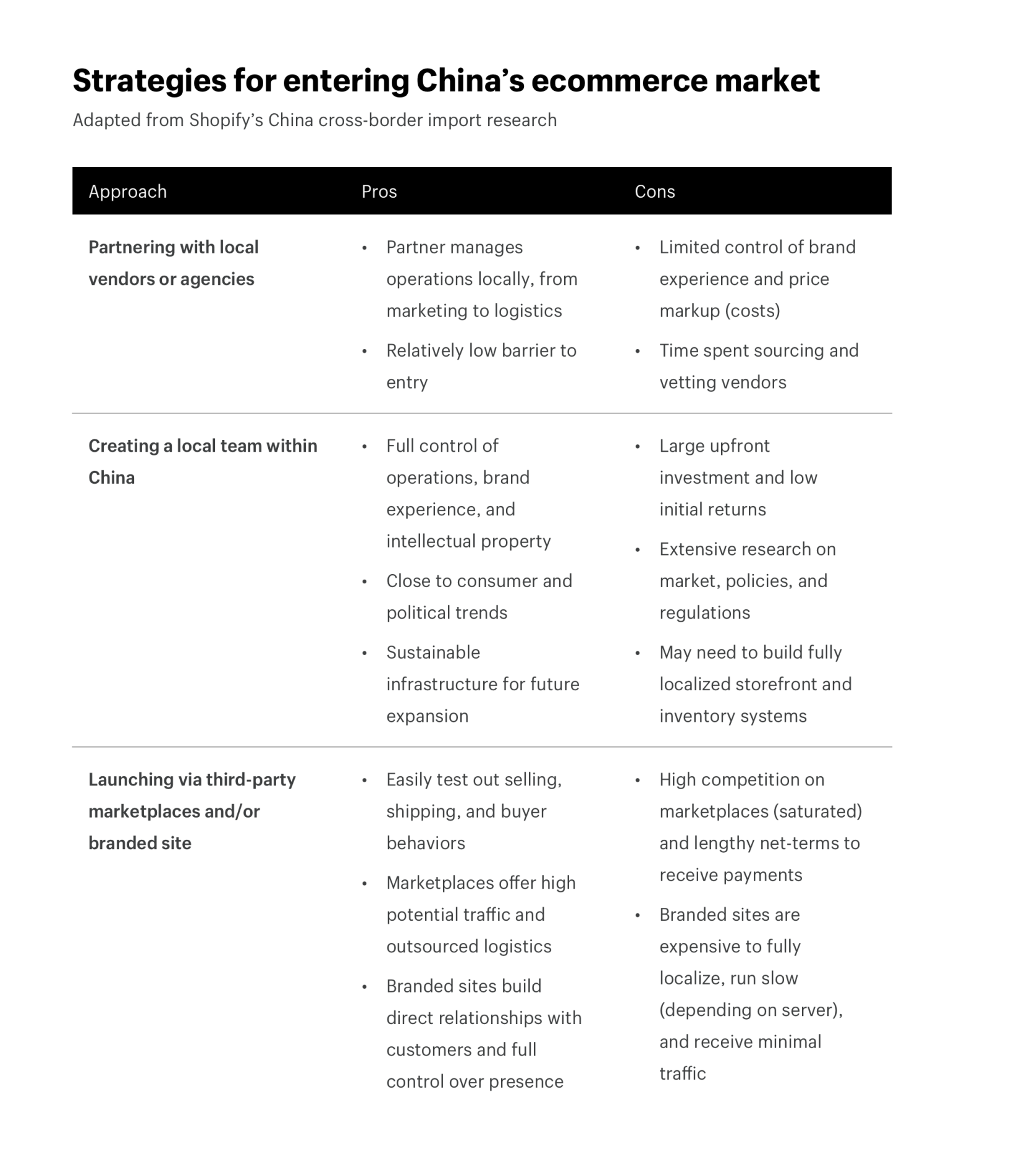
“There is no simple answer to China,” says Xavier Lee, Managing Director at Jumpstart Commerce, a Singapore-based agency with offices across Southeast Asia. “Reexamine your product to determine market fit. Start talking to Trade Associations. Get yourself on the digital ground with a WeChat account. Move around the different tier cities to glimpse how consumers behave. Be not afraid of growing slowly, be afraid only of standing still.”
Product-market fit varies by region and country
Making tactical decisions on which geographies to prioritize hinges on product-market fit: that is, validating existing demand or opportunity for your offerings within new areas. For instance, despite much effort (and money), deodorant has never become a successful product in China due primarily to biological reasons.
Thankfully, Nielsen’s Connected Commerce report provides a detailed breakdown of the most-lucrative online industries by region. Aligning those verticals with your own provides a solid starting point to guide global decisions.
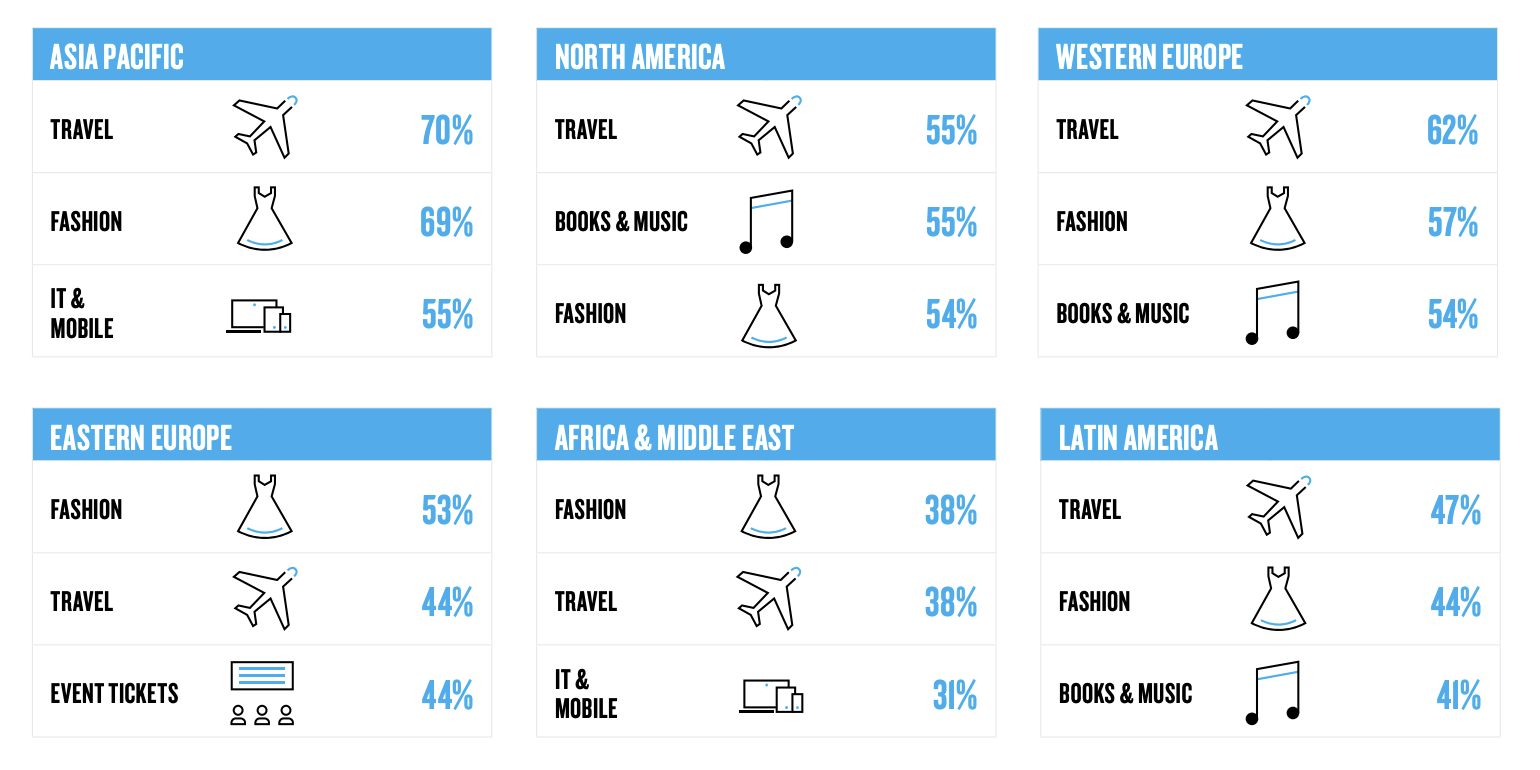
Equally important is determining geographic potentials. Once a region has been identified, a country-by-country analysis should follow. NC State University’s Estimating Market Potential: Is There a Market? does this by outlining seven steps:
- Define the market segment.
- Define the geographic boundaries.
- Define the local competition.
- Define the market’s monetary size.
- Estimate reasonable market share.
- Determine average annual consumption.
- Estimate an average selling price.
International analytics hold the key
Of course, even the best-informed speculation pales in comparison to the insights contained within the geography of current customers and visitors. You can uncover this by analyzing traffic and sales-by-country data.
With Google Analytics’ locations report (Audience > Geo > Location), set up segments to examine international traffic by continent, country, region, or city. Take special note of the areas where traffic and conversion rates are highest—these may represent where you’ve unknowingly gone global already.
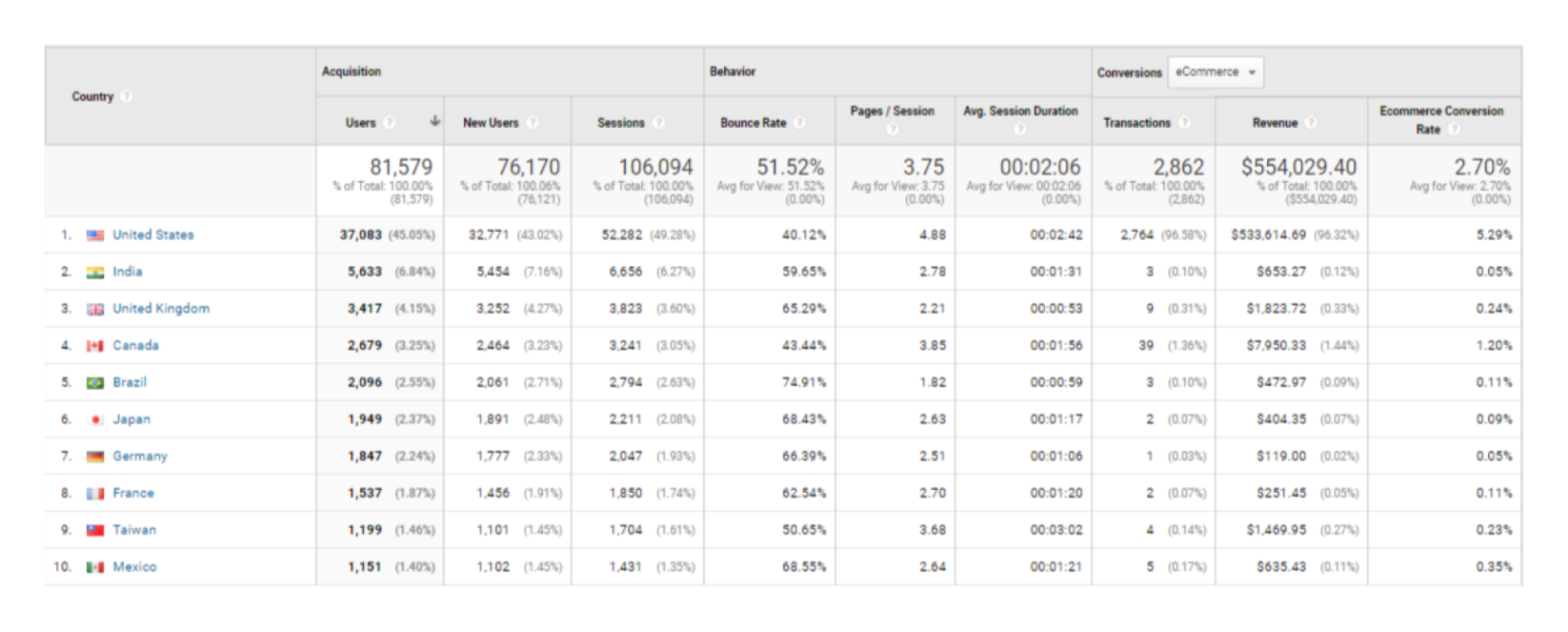
Also, pay attention to the areas where traffic may be high but conversions are low—these are likely clues as to where there is demand for your products but something onsite (e.g., language, currency, payment options, etc.) is a barrier to purchase.
Alternatively, if your ecommerce platform offers native reporting, examine the dashboards that show sessions by location (traffic), customers by country (shipping addresses), and sales by billing country (payment addresses).
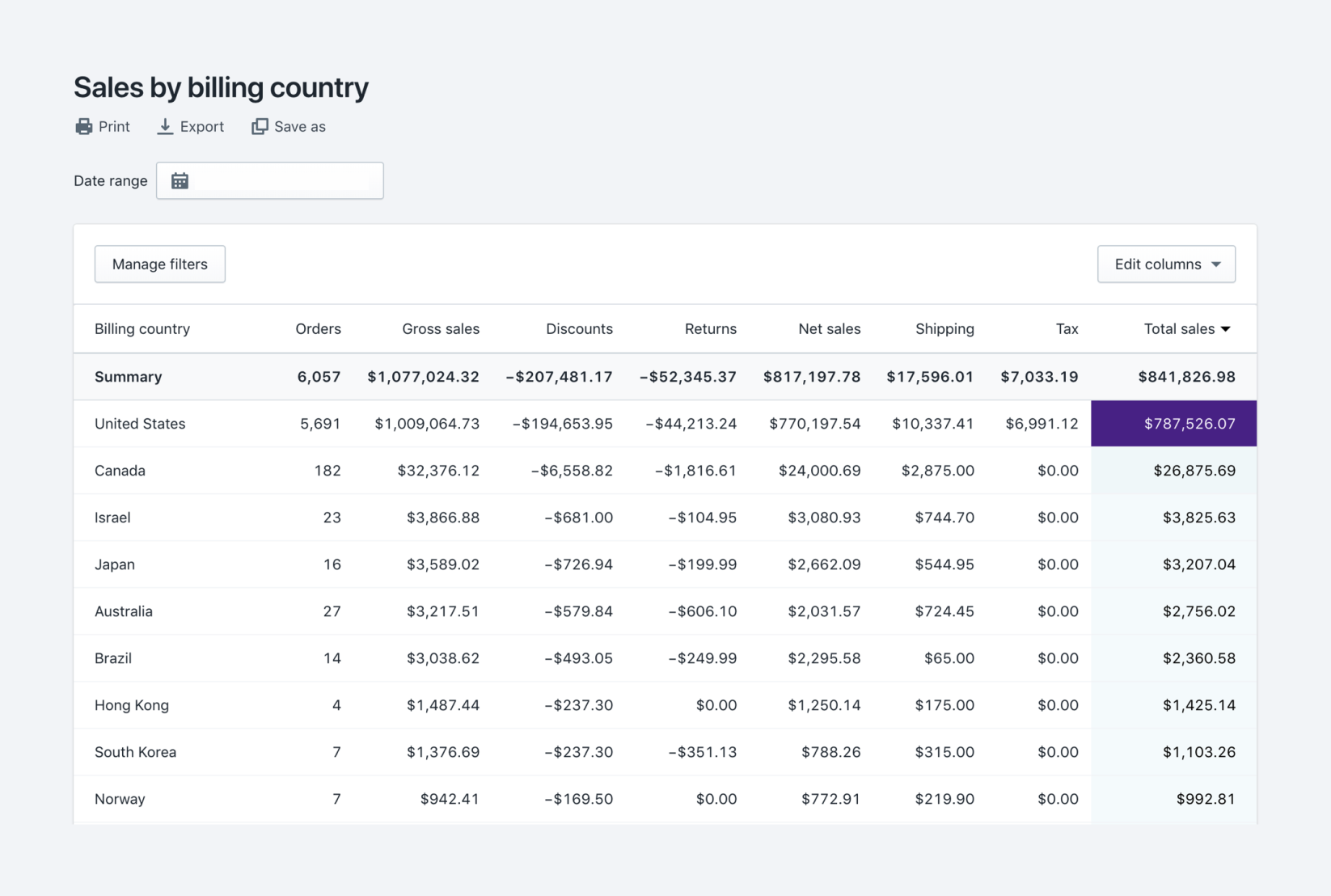
“You wouldn’t believe the demand for Piper in countries like Australia, Japan, and Canada,” says Tommy Gibbons, Director of Marketing at Piper. “Shopify Plus allows us to easily see the location of our sales so we can quickly begin to advertise in parts of the world where we see the best product-market fit.”
Learn more: International Ecommerce Issues: How to Diagnose Global Barriers with Analytics
Localized language matters most
Going native with your site’s language—beyond Google Translate—can make or break global sales. It creates a good customer experience from first impression to checkout.
Based on a survey of 8,709 global consumers in 29 countries, CSA Research found that 65% of consumers prefer content in their language, even if it’s poor quality. Moreover, 40% will not buy from websites in other languages.
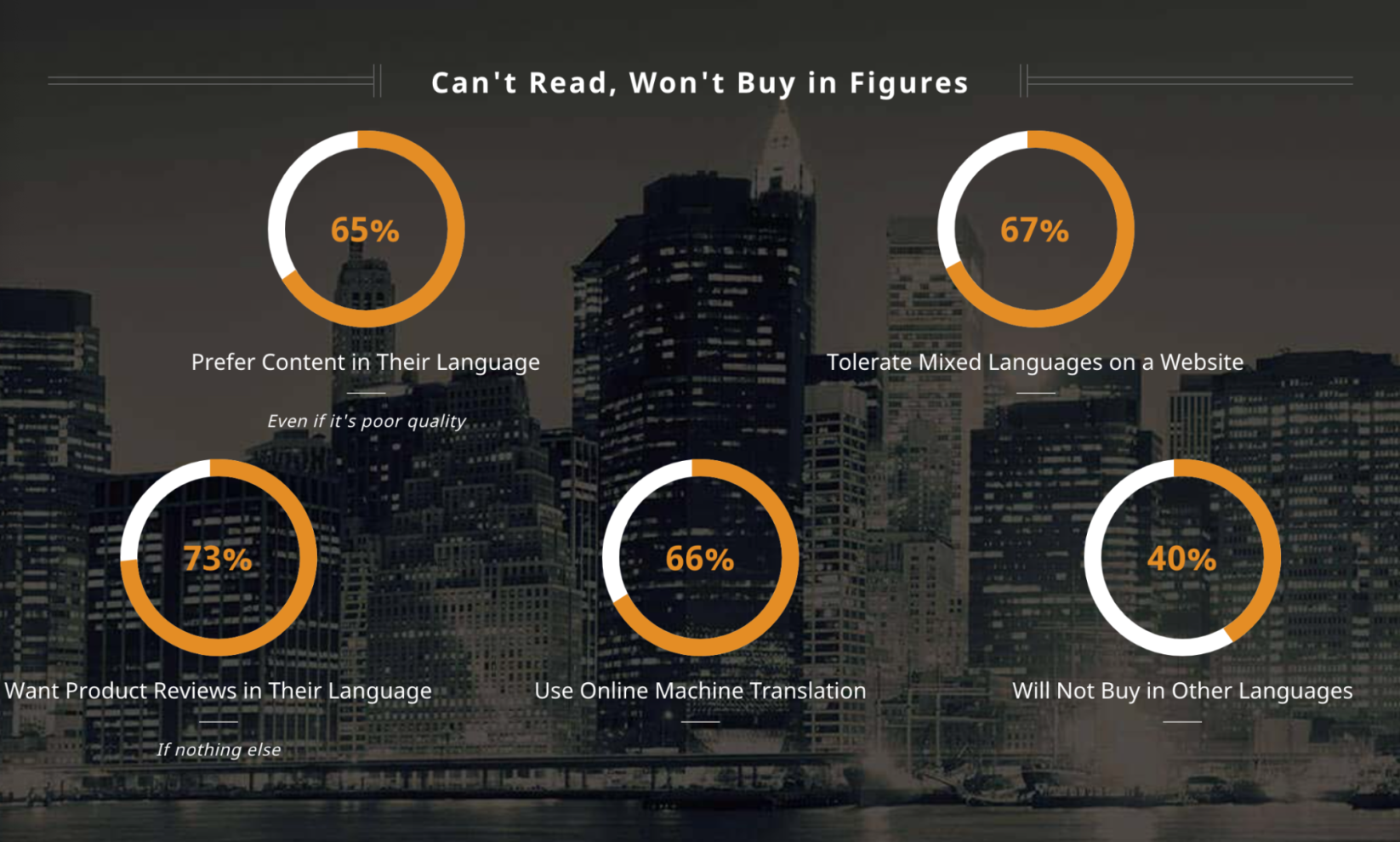
This last finding bears closer examination. Localization can often feel overwhelming, like an all-or-nothing endeavor (either everything has to be country-specific or why bother?). It’s not.
The respondents’ focus on navigation and “some” content means that a site need not invest in holistic translation from the jump. Getting heavily scrutinized areas of a site right is critical: headlines, product titles, etc. Only after you’ve gained traction does full-scale translation using a native copywriter and local idioms make sense.
Payment preferences vary around the world
Online payment methods weigh heavily on buying decisions. Still, it’s easy to overlook how people pay. Cultural-centricity blinds us to the differences in purchase habits. Without carefully considering the data, companies may default to whatever payment methods have been working domestically.
The coronavirus pandemic sped up consumers’ adoption of real-time payment options by 41%. Global mobile payments make up 46% of that figure, equalling a total of $102.7 billion last year. Real-time payment refers to digital wallet options where they can make payments quickly, such as Apple Pay, Google Pay, Shop Pay, and PayPal.
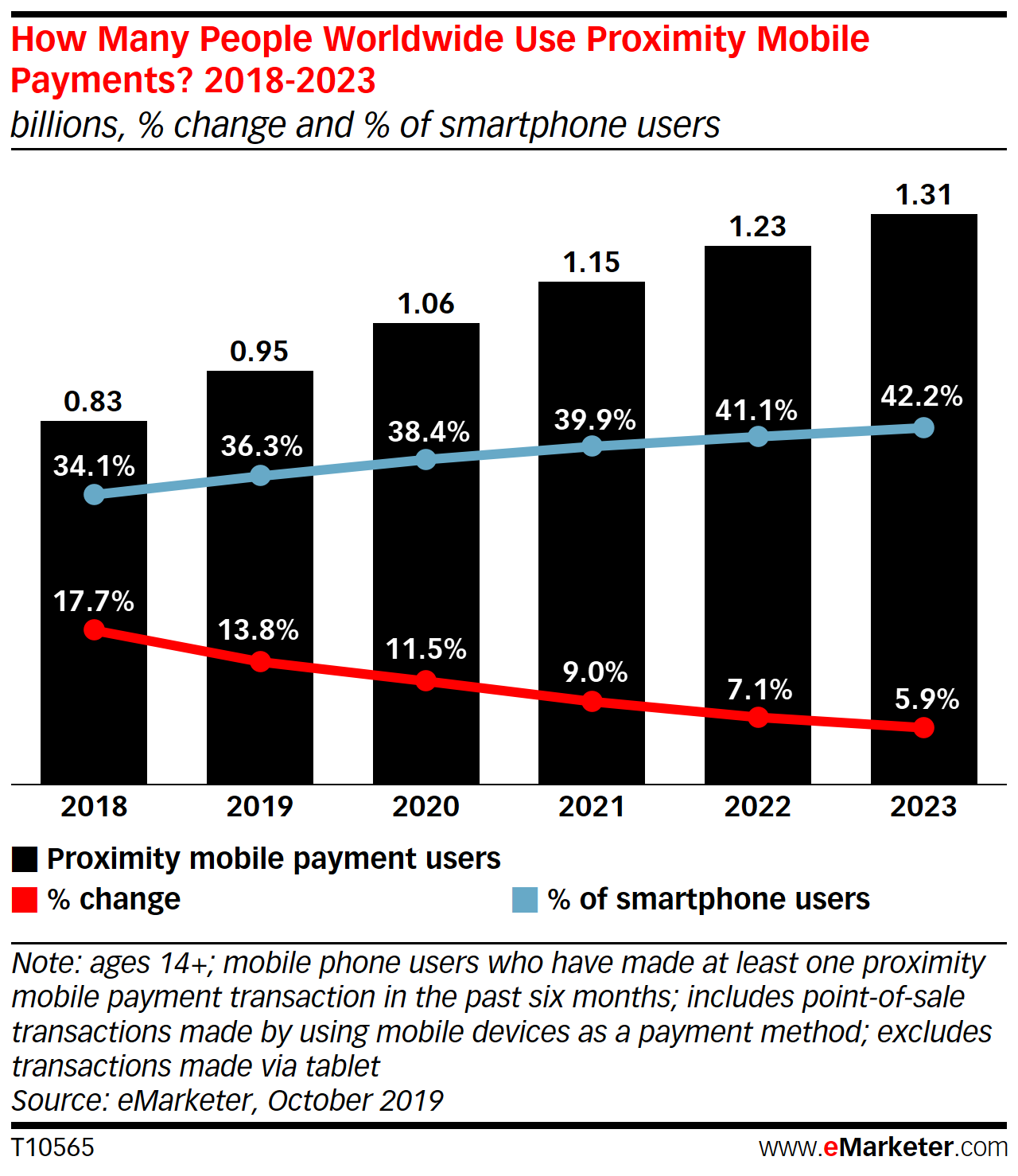
But every region still has its own preferred methods.
It’s no surprise that in North America, credit cards are number one by a mile. Digital payment systems like PayPal and Apple Pay are a close second. At the global scale, credit cards and those same digital payments also dominate.
Unlike North America, cash on delivery is a top choice in Eastern Europe, India, Africa, and throughout the Middle East. Similarly, enabling direct debit is a must if your target markets include India, Africa, or Asia.
For some, the differences in preference are small. For others, the gap is wide. But if you want to expand globally, you want to consider payment options for your target region.
Ethics and expansion “paths” are universal
Fair business practices and the three “paths” to expansion (detailed below) are two places where a one-size-fits-all system makes sense. The best source for getting global ethics right is the Federal Trade Commission’s Electronic Commerce: Selling Internationally—A Guide for Businesses, which 28 countries have signed. The guide provides a host of questions every business should face head-on:
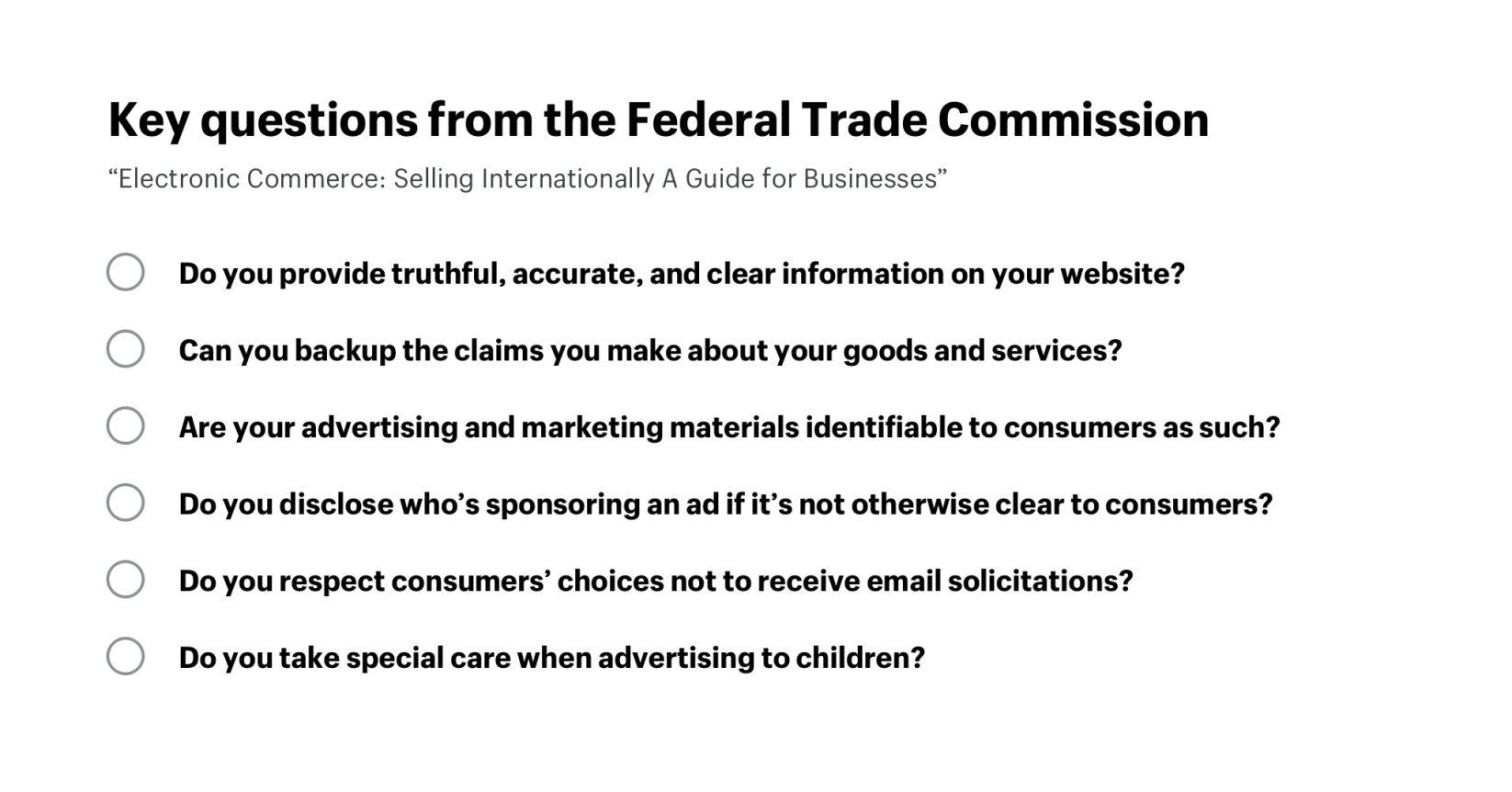
As for expansion, Forrester indicates that digital businesses “tend to follow a similar path and prioritize the same list of countries.”

That list of countries is helpful, but the characteristics of each “path” should be weighed carefully.
Top-tier markets:
- Large and developed ecommerce presence
- Smaller markets with strong physical infrastructures
- Ripe product markets within smaller overall markets
Second wave:
- Early-stage ecommerce development
- Complex domestic regulations
- Digitally advanced countries but small market sizes
Wait and see:
- Uncertain political climates
- Emerging ecommerce markets with long-term potential
- Challenging infrastructures
B2B’s ecommerce will dominate B2C
Statista’s B2B ecommerce report summarizes the situation with a punch: “Even though B2C eCommerce has witnessed widespread adoption, it is the recent evolution and growth of B2B eCommerce that is attracting the attention of buyers, sellers and investors all over the world.” Comparing each market’s total annual value represents a nearly four-fold difference (278.6%).
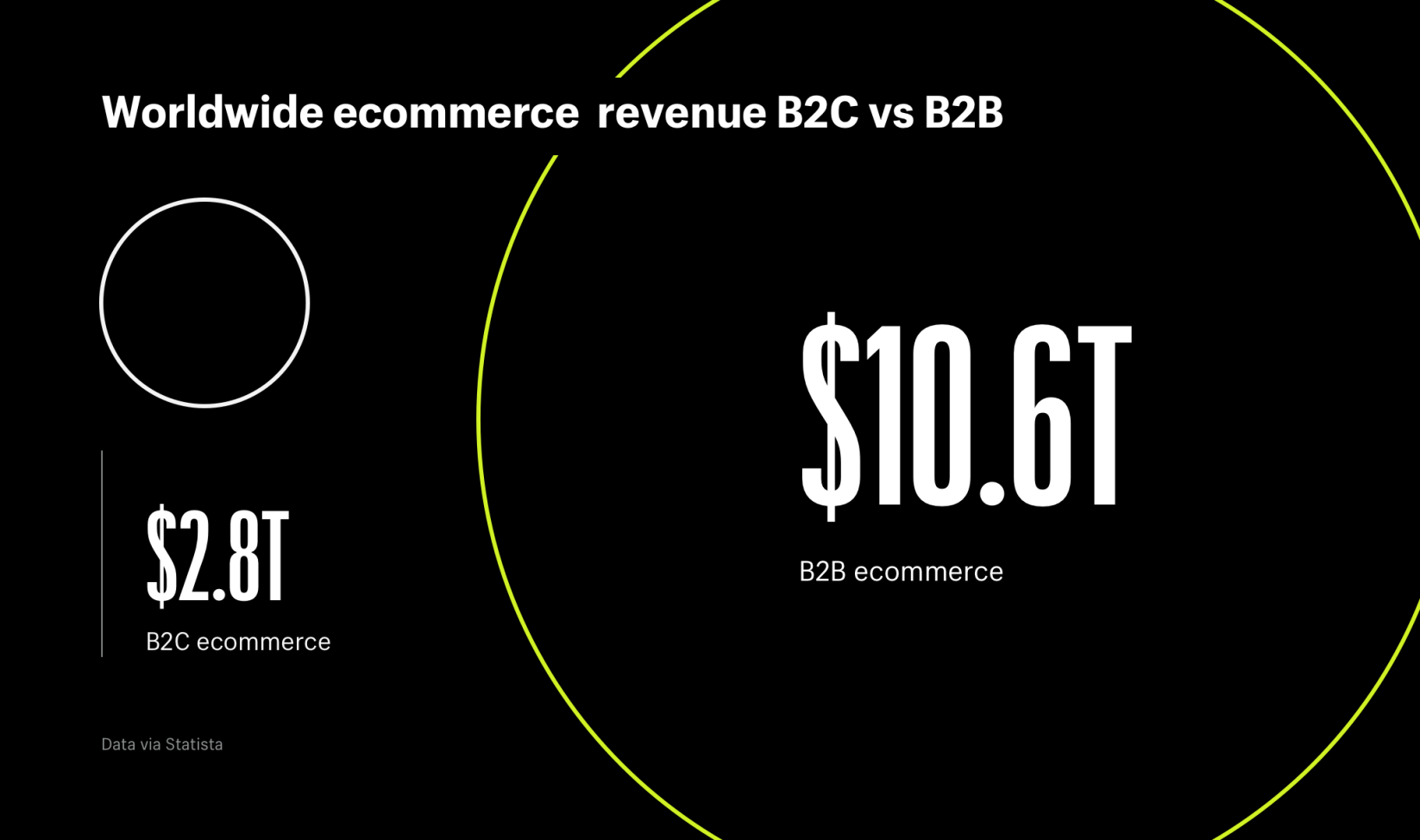
Why is B2B ecommerce such a ripe global opportunity?
- B2B marketplaces (e.g., Amazon Business, eWorldTrade, Joor, Alibaba, etc.) operate much like their B2C counterparts. They provide ready-made connections between buyers and sellers.
- The B2C preference for self-service has infiltrated B2B and alleviated the offline barrier of hiring a large sales force. Gartner found that B2B “customers now wait until they are 57% through the purchase process before contacting a rep.” This gives ecommerce a distinct advantage as self-guided online sales are already the norm.
Lastly, many wholesale ecommerce customers prefer simple ordering experiences. This is particularly true for independent e-retailers, small-to-medium franchises, and B2C outlets. Such buyers still often rely on paper orders and invoices.
Recreating line sheets in digital form and onboarding new wholesale customers with easy-to-follow reordering processes eliminates the need to create a wholesale channel with all the bells and whistles of B2C ecommerce.
It’s time to go cross-border
If there’s one thing all the above data, reports, and trends reveal, it’s that global ecommerce isn’t a choice; it’s a necessity. The future of your company’s growth, maybe even its survival, depends on it. That’s why we created a step-by-step framework for going global the right way.
It’s not a luxury. It’s not for multinational conglomerates. And it’s not just one among many growth strategies. Global ecommerce is a necessity, and something to take advantage of for your brand.
